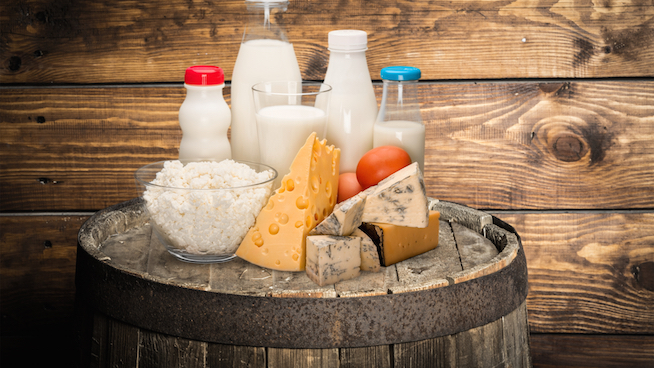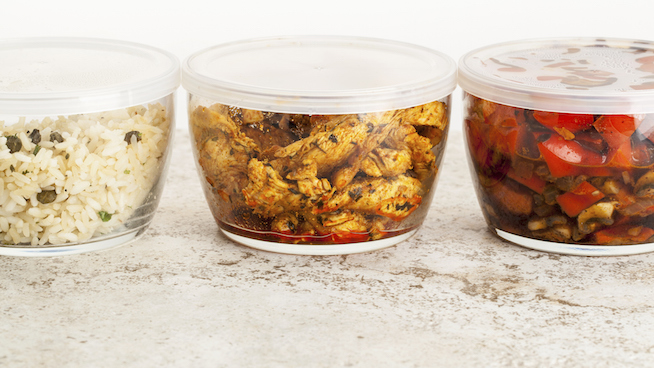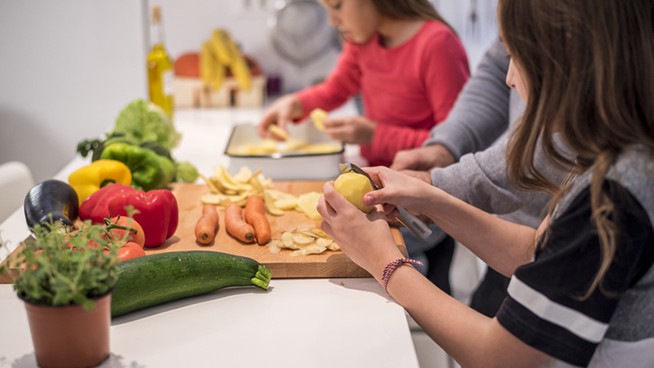Slash Weight By Eating Right (Not Less)
Dieting sucks. Let’s not sugarcoat it (and if you’re cutting back on calories, sugar is probably something you’re craving right now).
When you’re dieting, there’s less food on your plate every time you look at it. The pounds slip away, but so might your sanity.
“Most people, when they try and lose weight, they simply diminish their portions because they think that’s the thing to do,” says Leslie Bonci, RD. “But your stomach doesn’t automatically adjust to the fact that you’re feeding it half the amount [you once did]. That’s why people end up sabotaging themselves.”
The trick to dropping pounds and keeping them off? You need to eat more food.
No, that’s not a typo. And don’t get us wrong, we’re not saying consume more calories. But you can absolutely eat a higher volume of food while taking in fewer calories, provided you factor in something called “energy density.”
Density Versus Volume
Have you ever heard the question “which weighs more, a pound of feathers or a pound of lead?” Switch out feathers and lead for butter and spinach, and you’ll begin to get an idea of what we mean by “energy density.” Both weigh the same amount, but a pound of butter has far more calories than a pound of spinach. Salad is a low-density food, whereas butter is a high-density food.
OK, so how can you put this to good use?
Consider chicken and rice. The chicken is denser (approximately 151 calories per 100 grams versus 131 in the rice). But you don’t want to lose the chicken, a lean source of muscle-building protein. Bonci suggests replacing the food you have the highest volume of—the rice—with an equal volume of roasted veggies, which have a lower caloric density.
“There’s this idea of being eye thrilling and gut filling,” says Bonci. “If you look at food and say, ‘That’s a tiny amount, I’m going to be hungry when I’m done,’ then you will be hungry! If you look and say, ‘Wow, look at that big volume,’ [then you will feel different].”
After swapping out some of your rice for roasted vegetables, your plate still appears full, and your stomach gets that comfortable feeling, without a drastic caloric hit.
“I don’t feel deprived, and my stomach doesn’t feel deprived [after making this change],” Bonci says. “I’ve also probably increased the nutritional value because I’ve added some vegetables to the mix while decreasing the calories.”
Water and Fiber
Both water and fiber contribute to a food’s energy density. Fiber is not digested, it’s simply ingested and expelled, while water provides no calories. So it’s not surprising that watery, fibrous foods (like apples and oranges) are a great way to add volume to a meal without adding empty calories.
Plus, Bonci adds, “Some fibrous foods simply take longer to eat—you have to work your way through an apple. [Fiber] gives you that feeling of fullness. It takes longer for fiber-containing foods to leave the stomach. So what’s the difference between an apple and apple juice? They could have the same amount of calories, but the apple has more fiber so it’s going to give you that fullness for a longer period of time.”
Doing the Math
Curious to find out how dense your diet is? Simply determine the total number of calories present in a meal, as well as how many grams of food you’re eating. Then divide the calories by the grams. The result tells you the calories per gram, which is how you determine the density of your meal.
The lower that number, the fewer calories you’ll consume and the higher the likelihood that you’ll lose weight (assuming you stick to the plan in the long run).
So if you’re serious about losing weight, calculate the energy density of the meals you’re already eating. Break the meals down into their individual components and find the densest food, then replace some or all of that item with a food that doesn’t offer as many calories in the same volume. Do it right and stick to the plan, and odds are that your waist will shrink without your even realizing it.
Reference:
http://www.cdc.gov/nccdphp/dnpa/nutrition/pdf/r2p_energy_density.pdf
RECOMMENDED FOR YOU
Slash Weight By Eating Right (Not Less)
Dieting sucks. Let’s not sugarcoat it (and if you’re cutting back on calories, sugar is probably something you’re craving right now).
When you’re dieting, there’s less food on your plate every time you look at it. The pounds slip away, but so might your sanity.
“Most people, when they try and lose weight, they simply diminish their portions because they think that’s the thing to do,” says Leslie Bonci, RD. “But your stomach doesn’t automatically adjust to the fact that you’re feeding it half the amount [you once did]. That’s why people end up sabotaging themselves.”
The trick to dropping pounds and keeping them off? You need to eat more food.
No, that’s not a typo. And don’t get us wrong, we’re not saying consume more calories. But you can absolutely eat a higher volume of food while taking in fewer calories, provided you factor in something called “energy density.”
Density Versus Volume
Have you ever heard the question “which weighs more, a pound of feathers or a pound of lead?” Switch out feathers and lead for butter and spinach, and you’ll begin to get an idea of what we mean by “energy density.” Both weigh the same amount, but a pound of butter has far more calories than a pound of spinach. Salad is a low-density food, whereas butter is a high-density food.
OK, so how can you put this to good use?
Consider chicken and rice. The chicken is denser (approximately 151 calories per 100 grams versus 131 in the rice). But you don’t want to lose the chicken, a lean source of muscle-building protein. Bonci suggests replacing the food you have the highest volume of—the rice—with an equal volume of roasted veggies, which have a lower caloric density.
“There’s this idea of being eye thrilling and gut filling,” says Bonci. “If you look at food and say, ‘That’s a tiny amount, I’m going to be hungry when I’m done,’ then you will be hungry! If you look and say, ‘Wow, look at that big volume,’ [then you will feel different].”
After swapping out some of your rice for roasted vegetables, your plate still appears full, and your stomach gets that comfortable feeling, without a drastic caloric hit.
“I don’t feel deprived, and my stomach doesn’t feel deprived [after making this change],” Bonci says. “I’ve also probably increased the nutritional value because I’ve added some vegetables to the mix while decreasing the calories.”
Water and Fiber
Both water and fiber contribute to a food’s energy density. Fiber is not digested, it’s simply ingested and expelled, while water provides no calories. So it’s not surprising that watery, fibrous foods (like apples and oranges) are a great way to add volume to a meal without adding empty calories.
Plus, Bonci adds, “Some fibrous foods simply take longer to eat—you have to work your way through an apple. [Fiber] gives you that feeling of fullness. It takes longer for fiber-containing foods to leave the stomach. So what’s the difference between an apple and apple juice? They could have the same amount of calories, but the apple has more fiber so it’s going to give you that fullness for a longer period of time.”
Doing the Math
Curious to find out how dense your diet is? Simply determine the total number of calories present in a meal, as well as how many grams of food you’re eating. Then divide the calories by the grams. The result tells you the calories per gram, which is how you determine the density of your meal.
The lower that number, the fewer calories you’ll consume and the higher the likelihood that you’ll lose weight (assuming you stick to the plan in the long run).
So if you’re serious about losing weight, calculate the energy density of the meals you’re already eating. Break the meals down into their individual components and find the densest food, then replace some or all of that item with a food that doesn’t offer as many calories in the same volume. Do it right and stick to the plan, and odds are that your waist will shrink without your even realizing it.
Reference:
http://www.cdc.gov/nccdphp/dnpa/nutrition/pdf/r2p_energy_density.pdf











